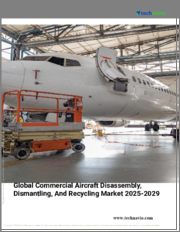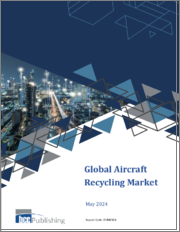
|
시장보고서
상품코드
1627996
항공기 재활용 시장 전망 : 기회, 성장 촉진 요인, 산업 동향 분석(2025-2034년)Aircraft Recycling Market Opportunity, Growth Drivers, Industry Trend Analysis, and Forecast 2025 - 2034 |
||||||
세계의 항공기 재활용 시장은 2024년 기준 53억 달러(USD)에 이르렀으며, 2025년부터 2034년까지 연평균 성장률(CAGR)은 9.7%로 큰 성장이 예측되고 있습니다.
이 시장은 세계의 항공기 보유 대수 증가와 항공기의 퇴역 속도의 가속화로 확대되고 있습니다. 항공사들은 운항 비용 절감 및 환경 목표 달성을 위해 구형기를 연비 효율이 높은 항공기로 교체하고 있습니다. 이에 따라 항공기의 퇴역 빈도가 증가하면서 재활용 및 해체 서비스에 대한 수요가 높아지고 있습니다. 또한 업계 각사는 지속가능성 향상과 재활용 프로세스 최적화를 목표로 재활용업체, 제조업체, 기술 업체 간 전략적 협업이 지속 가능성을 강화하고 재활용 프로세스를 죄적화하면서 시장 성장에 기여하고 있습니다.
항공기 재활용 분야는 지속 가능성, 효율성, 기술 혁신에 중점을 두면서 진화하고 있습니다. 기업들은 더 많은 자재를 회수하고 폐기물을 최소화하는 것을 목표로 재활용 프로세스를 개선하기 위해 노력하고 있습니다. 자동화와 같은 첨단 기술에 대한 투자로 보다 정밀한 해체 작업을 가능해지고 있습니다. 더불어 항공기 제조업체, 항공사 및 재활용 업체 간의 협력 관계 증가하면서 항공기의 수명종료(end-of-life) 솔루션이 종합적으로 발전하고 있으며, 재활용 프로세스의 전반적인 효율성을 높이고 있습니다.
시장은 재료의 유형에 따라 티타늄 합금, 알루미늄 및 기타 재료로 구분됩니다. 그 중에서도 알루미늄이 가장 높은 성장을 이루며 2025-2034년의 연평균 성장률(CAGR)은 9.5%로 예측됩니다. 알루미늄은 항공기의 주요 구성 재료로, 재활용 산업에서 높은 수요를 보입니다. 항공사와 운항사들이 지속가능한 운영방식을 도입함에 따라 알루미늄 재활용은 환경 영향을 줄이기 위한 핵심적인 요소가 되고 있습니다. 퇴역 항공기에서 회수된 알루미늄은 귀중한 자원을 절약할 뿐만 아니라, 새로운 알루미늄 생산에 비해 에너지 소비가 크게 적어 자동차, 건설, 제조 등 다양한 산업에서 매력적인 선택으로 자리잡게 되었습니다.
| 시장 범위 | |
|---|---|
| 시작 연도 | 2024년 |
| 예측 연도 | 2025-2034년 |
| 시작 시장 규모 | 53억 달러(USD) |
| 예측 시장 규모 | 132억 달러(USD) |
| 연평균 성장률(CAGR) | 9.7% |
이 시장은 좁은 바디 기계, 넓은 바디 기계, 지역 제트기, 터보프롭 기계 등 항공기로 분류됩니다. 좁은 바디 기계 부문은 단거리 및 중거리 노선에서 높은 비중을 차지함에 따라 시장을 선도하고 있습니다. 이들은 설계가 간단하고 부품이 작아 재활용이 용이하므로 재활용업체에서 선호됩니다. 또한 저비용 항공사와 지역 항공사의 의한 좁은 바디기계 항공기 사용 증가가 퇴역 항공기 재활용수요의 증가로 이어지고 있습니다.
북미 항공기 재활용 시장은 2024년 53.6%의 점유율을 차지했습니다. 미국 시장 성장은 항공사, 제조업체, 규제기관이 보다 친환경적인 항공기 폐기 방법을 추진하고 있으며 지속가능성이 강하게 중시되고 있다는 배경이 되고 있습니다. 항공기의 노후화와 근대화에 따라 친환경 재활용 방법에 대한 수요는 계속 증가하고 있으며, 폐기물을 삭감하면서 알루미늄이나 티타늄 등의 귀중한 소재를 회수하는 신기술의 채용이 촉진되고 있습니다.
목차
제1장 조사 방법과 조사 범위
제2장 주요 요약
제3장 업계 통찰
- 생태계 분석
- 밸류체인에 영향을 주는 요인
- 이익률 분석
- 파괴
- 장래의 전망
- 제조업체
- 유통업체
- 공급자의 상황
- 이익률 분석
- 주요 뉴스
- 규제 상황
- 영향요인
- 성장 촉진요인
- 항공기 보유 대수 증가와 퇴역
- 재활용 기술의 진보
- 애프터마켓 부품 수요 증가
- MRO(정비, 수리, 오버홀) 섹터의 성장
- 군용기·방위기의 재활용 증가
- 업계의 잠재적 위험 및 과제
- 복잡하고 비용이 많이 드는 해체 프로세스
- 신흥 시장의 제한된 인프라와 표준화
- 성장 촉진요인
- 성장 가능성 분석
- Porter's Five Forces 분석
- PESTEL 분석
제4장 경쟁 구도
- 소개
- 기업 점유율 분석
- 경쟁 포지셔닝 매트릭스
- 전략 전망 매트릭스
제5장 시장 추계 및 예측 : 항공기별(2021-2034년)
- 주요 동향
- 좁은 바디
- 엔진
- 착륙장치
- 기체
- 아비오닉스
- 기타
- 넓은 바디
- 엔진
- 착륙장치
- 기체
- 항공전자기기
- 기타
- 지역 제트기
- 엔진
- 착륙장치
- 기체
- 항공전자기기
- 기타
- 터보프롭
- 엔진
- 착륙장치
- 기체
- 항공전자기기
- 기타
제6장 시장 추계 및 예측 : 유형별(2021-2034년)
- 주요 동향
- 여객기
- 화물기
제7장 시장 추계 및 예측 : 재료별(2021-2034년)
- 주요 동향
- 알루미늄
- 티타늄 합금
- 기타
제8장 시장 추계 및 예측 : 지역별(2021-2034년)
- 주요 동향
- 북미
- 미국
- 캐나다
- 유럽
- 영국
- 독일
- 프랑스
- 이탈리아
- 스페인
- 러시아
- 아시아 태평양
- 중국
- 인도
- 일본
- 한국
- 호주
- 라틴아메리카
- 브라질
- 멕시코
- 중동 및 아프리카
- 남아프리카
- 사우디아라비아
- 아랍에미리트(UAE)
제9장 기업 프로파일
- Aerocycle
- Aircraft End-of-Life Solutions
- Aircraft Recycling International Limited
- Airbus
- Apple Aviation
- Athens Aeroservices
- Aviation International Recycling SL
- CAVU
- ComAv
- Dubai Aerospace Enterprise
- KLM UK Engineering
- MoreAero GmbH
- Sycamore Aviation
- Tarmac Aerosave
- Vallair
The Global Aircraft Recycling Market reached USD 5.3 billion in 2024 and is projected to experience significant growth, with a CAGR of 9.7% from 2025 to 2034. The market is expanding due to the increasing global fleets and the accelerated pace of aircraft retirements. Airlines are replacing older models with more fuel-efficient aircraft to reduce operational costs and meet environmental targets. As a result, the frequency of aircraft retirements is rising, driving the demand for recycling and dismantling services. Additionally, industry players are forming strategic collaborations to enhance sustainability and optimize recycling processes, bringing together recyclers, manufacturers, and technology firms to leverage their expertise.
The aircraft recycling sector is evolving, focusing on sustainability, efficiency, and technological innovation. Companies are working to improve recycling processes, aiming to recover more materials and minimize waste. Investment in advanced technologies, such as automation enables more precise dismantling operations. Moreover, an increasing number of collaborations between aircraft manufacturers, airlines, and recyclers are contributing to the development of comprehensive end-of-life solutions for aircraft, enhancing the overall efficiency of the recycling process.
Based on material types, the market is segmented into titanium alloys, aluminum, and other materials. Among these, aluminum is expected to witness the highest growth, with a projected CAGR of 9.5% during 2025-2034. Aluminum is a major component of aircraft and is highly sought after in the recycling industry. As airlines and operators seek to adopt more sustainable practices, aluminum recycling has become an essential part of the industry's efforts to reduce environmental impact. The recycling of aluminum from retired aircraft not only conserves valuable resources but also uses significantly less energy compared to producing new aluminum, making it an attractive option for various industries such as automotive, construction, and manufacturing.
| Market Scope | |
|---|---|
| Start Year | 2024 |
| Forecast Year | 2025-2034 |
| Start Value | $5.3 Billion |
| Forecast Value | $13.2 Billion |
| CAGR | 9.7% |
The market is also categorized based on the type of aircraft, including narrow-body, wide-body, regional jets, and turboprop aircraft. The narrow-body segment leads the market due to the high volume of these aircraft in short- and medium-haul routes. Their simpler design and smaller components make them easier to recycle, making them a preferred choice for recyclers. The growing use of narrow-body aircraft by budget and regional carriers further contributes to the increasing number of retired planes being sent for recycling.
North America aircraft recycling market held a 53.6% share in 2024. The market's growth in the U.S. is driven by a strong emphasis on sustainability, with airlines, manufacturers, and regulatory bodies pushing for greener aircraft disposal practices. As fleets age and modernize, the demand for eco-friendly recycling methods continues to rise, promoting the adoption of new technologies to recover valuable materials like aluminum and titanium while reducing waste.
Table of Contents
Chapter 1 Methodology & Scope
- 1.1 Market scope & definitions
- 1.2 Base estimates & calculations
- 1.3 Forecast calculations
- 1.4 Data sources
- 1.4.1 Primary
- 1.4.2 Secondary
- 1.4.2.1 Paid sources
- 1.4.2.2 Public sources
Chapter 2 Executive Summary
- 2.1 Industry synopsis, 2021-2034
Chapter 3 Industry Insights
- 3.1 Industry ecosystem analysis
- 3.1.1 Factor affecting the value chain
- 3.1.2 Profit margin analysis
- 3.1.3 Disruptions
- 3.1.4 Future outlook
- 3.1.5 Manufacturers
- 3.1.6 Distributors
- 3.2 Supplier landscape
- 3.3 Profit margin analysis
- 3.4 Key news & initiatives
- 3.5 Regulatory landscape
- 3.6 Impact forces
- 3.6.1 Growth drivers
- 3.6.1.1 Increasing aircraft fleet and retirements
- 3.6.1.2 Advancements in recycling technologies
- 3.6.1.3 Increasing demand for aftermarket parts
- 3.6.1.4 Growth of the MRO (Maintenance, Repair, and Overhaul) sector
- 3.6.1.5 Increasing military and defense aircraft recycling
- 3.6.2 Industry pitfalls & challenges
- 3.6.2.1 Complex and costly dismantling processes
- 3.6.2.2 Limited infrastructure and standardization in emerging markets
- 3.6.1 Growth drivers
- 3.7 Growth potential analysis
- 3.8 Porter's analysis
- 3.9 PESTEL analysis
Chapter 4 Competitive Landscape, 2024
- 4.1 Introduction
- 4.2 Company market share analysis
- 4.3 Competitive positioning matrix
- 4.4 Strategic outlook matrix
Chapter 5 Market Estimates & Forecast, By Aircraft, 2021-2034 (USD Million)
- 5.1 Key trends
- 5.2 Narrow-body
- 5.2.1 Engines
- 5.2.2 Landing gear
- 5.2.3 Fuselages
- 5.2.4 Avionics
- 5.2.5 Others
- 5.3 Wide-body
- 5.3.1 Engines
- 5.3.2 Landing gear
- 5.3.3 Fuselages
- 5.3.4 Avionics
- 5.3.5 Others
- 5.4 Regional jets
- 5.4.1 Engines
- 5.4.2 Landing gear
- 5.4.3 Fuselages
- 5.4.4 Avionics
- 5.4.5 Others
- 5.5 Turboprop
- 5.5.1 Engines
- 5.5.2 Landing gear
- 5.5.3 Fuselages
- 5.5.4 Avionics
- 5.5.5 Others
Chapter 6 Market Estimates & Forecast, By Type, 2021-2034 (USD Million)
- 6.1 Key trends
- 6.2 Passenger
- 6.3 Cargo
Chapter 7 Market Estimates & Forecast, By Material, 2021-2034 (USD Million)
- 7.1 Key trends
- 7.2 Aluminum
- 7.3 Titanium alloys
- 7.4 other
Chapter 8 Market Estimates & Forecast, By Region, 2021-2034 (USD Million)
- 8.1 Key trends
- 8.2 North America
- 8.2.1 U.S.
- 8.2.2 Canada
- 8.3 Europe
- 8.3.1 UK
- 8.3.2 Germany
- 8.3.3 France
- 8.3.4 Italy
- 8.3.5 Spain
- 8.3.6 Russia
- 8.4 Asia Pacific
- 8.4.1 China
- 8.4.2 India
- 8.4.3 Japan
- 8.4.4 South Korea
- 8.4.5 Australia
- 8.5 Latin America
- 8.5.1 Brazil
- 8.5.2 Mexico
- 8.6 MEA
- 8.6.1 South Africa
- 8.6.2 Saudi Arabia
- 8.6.3 UAE
Chapter 9 Company Profiles
- 9.1 Aerocycle
- 9.2 Aircraft End-of-Life Solutions
- 9.3 Aircraft Recycling International Limited
- 9.4 Airbus
- 9.5 Apple Aviation
- 9.6 Athens Aeroservices
- 9.7 Aviation International Recycling SL
- 9.8 CAVU
- 9.9 ComAv
- 9.10 Dubai Aerospace Enterprise
- 9.11 KLM UK Engineering
- 9.12 MoreAero GmbH
- 9.13 Sycamore Aviation
- 9.14 Tarmac Aerosave
- 9.15 Vallair
















